The Samsung Galaxy S9+ is the South Korean manufacturer’s top-end Galaxy S-series smartphone, offering all-round high-end specifications, including a Qualcomm Snapdragon 845 chipset and a 6.2-inch Super AMOLED display. Its 12Mp rear dual-camera with 2x optical zoom is one of the best that we have tested, but the front shooter (the subject of this article) has a lot to offer as well.
The Galaxy S9+ front camera comes with a 1/3.6″ 8Mp sensor. Light is channeled through a lens with a fast f/1.7 aperture and an equivalent focal length of 25mm, allowing for group selfies without the need for a selfie-stick. In very low light, you can activate the display flash function for additional subject illumination. The S9+ is also one of just a very few devices to offer an AF system in its front camera, which should at least in theory allow for more flexibility in terms of subject distance compared to the competition’s fixed-focus offerings.
Key front camera specifications:
- 8Mp 1/3.6″ sensor with 1.22µm pixel size
- f/1.7 aperture lens
- 25mm-equivalent focal length
- Autofocus
- Display flash
- 1440p@30fps
About DxOMark Selfie tests: For scoring and analysis in our smartphone front camera reviews, DxOMark engineers capture and evaluate over 1500 test images and more than 2 hours of video both in controlled lab environments and in natural indoor and outdoor scenes, using the camera’s default settings. This article is designed to highlight the most important results of our testing. For more information about the DxOMark Selfie test protocol, click here.
Test summary


With an overall score of 81 points, the Samsung Galaxy S9+ offers decent front camera performance, but cannot quite keep up with the currently best in class, such as Samsung’s own Galaxy Note 9. This said, the S9+ was a top performer at the time of its launch, and a noticeable improvement over its predecessor, the S8. The Photo score of 81 points is very good, thanks mainly to accurate target exposure, natural skin tones, and low noise levels in most shooting scenarios. The Galaxy S9+ offers autofocus in the front camera and we found the system to work accurately and consistently on most occasions in stills mode.
The Samsung is not perfect, however, and it is worth keeping mind its limitations in some shooting situations. An important limitation is its lack of dynamic range, which in high-contrast scenes can often lead to clipped highlights on skin tones and/or in the background of a self-portrait. Color isn’t always spot-on, either. We often observed a slight yellow or green cast in images captured in bright outdoor conditions, and color saturation is a little lower than usual in many different conditions, resulting in a color response that is a bit less vivid than on competing devices.
There is some room for improvement in terms of image detail, too. Finer details are blurred away by noise reduction, even when shooting in bright light. At longer subject distances, the focus on the subject can be a touch soft, especially when shooting with the help of a selfie-stick.
In video mode, the Galaxy S9+ achieves 81 points for its front camera. Videos usually show good target exposure on faces; noise levels are low across the board; and the auto white balance system delivers mostly neutral colors in bright light. However, there are some opportunities for improvement here as well—for example, the S9+’s front-camera AF system causes more problems than it does good. Focus on the subject is usually good, but the lens frequently refocuses without any obvious reason, especially at the start of video recording. Dynamic range is just as limited as in stills mode, resulting in clipped highlights. Color saturation is lower than usual in many shooting situations as well.
Photo scores explained
With a total Photo score of 81 points, the Samsung Galaxy S9+ front camera achieves a good score for still images in our testing. The overall Photo score is calculated from sub-scores in tests that examine different aspects of its performance under different lighting conditions. In this section, we’ll take a closer look at these image quality sub-scores.

Exposure and Contrast
Samsung Galaxy S9+
72
91
With 72 points, the Samsung Galaxy S9+ front camera achieves a very good score for exposure, thanks to good target exposure on the face in almost all shooting situations. The camera’s main weakness, as far as exposure goes, is dynamic range. Compared to some direct rivals, the S9+’s dynamic range is quite limited. This frequently leads to highlight clipping in brighter parts of the background, as you can see in the sample comparison below. The Samsung achieves a very good exposure of the subject’s face, but compared to the iPhone X, there are a lot more clipped areas in the background. The Pixel 2 also records better background detail, but captures a slightly underexposed image.
The lack of dynamic range can also lead to clipping on skin tones in harsher lighting conditions, as is clearly noticeable in our backlit indoor comparison below. Very little detail is left in the overexposed background, and in addition, the subject’s face is noticeably underexposed and rendered too dark. The iPhone X and Pixel 2 don’t do much better in terms of background exposure (the iPhone is actually even worse than the Samsung), but both manage much better exposure of the face and better overall exposure balance.
The S9+ front camera also generally does a very good job with groups of people in the picture. In most conditions, target exposure is good across all faces in the image; we occasionally observed some overexposure on the faces of the subjects furthest away from the camera, but only in low artificial light indoors.
In the graph of our exposure lab test data below, you can see that the Galaxy S9+ delivers good exposure from light levels of around 20 lux all the way up to a bright 1000 lux. Images get a little darker if you shoot in very low light, but the Samsung has that in common with its direct rivals. Exposure is a touch lighter than on the iPhone X and Google Pixel 2 across all light levels, but well within acceptable limits. It also means the S9+ will get you the best exposures out of these three devices in very dim conditions.
On the downside, we found occasional exposure instabilities with the Galaxy S9+, with subsequent frames in a series of images of the same scene showing slight but noticeable variances in exposure.

Color
Samsung Galaxy S9+
65
105
At 65 points, the Samsung Galaxy S9+ puts in a decent performance for color. In most shooting conditions, its rendering of skin tones is pleasant and natural, although there is sometimes a slightly yellow or green cast noticeable in the background scenery when shooting out in the open. This is quite easy to spot in our comparison with the iPhone X and Pixel 2, both of which render a more neutral color in the background.
While skin tones are mostly pleasant, occasionally we have found a slight orange cast on the faces in our test samples, and on very rare occasions we have also witnessed slight white balance instabilities between shots in a series of images. One thing the Galaxy S9+ front camera’s auto white balance system struggles with is portraits taken in front of a plain-colored background. You can see one of the more extreme samples in the comparison shots below. The plain blue background has thrown the S9+’s white balance completely off, resulting in very warm and unnatural skin tones. The iPhone X and Pixel 2 don’t have any major problems with the same scene and produce much better color.
We also found that color saturation on the Samsung Galaxy S9+ front camera is a little low in some indoor and low-light shooting conditions.

Focus
Samsung Galaxy S9+
48
97
With a score of 48, the Galaxy S9 front camera performs well in the Focus category, delivering mostly accurate and consistent results. That said, despite its front-camera AF, the S9+ still has some room for improvement. Subjects are in focus at a short subject distance of 30cm. At 55cm, results are still good, but a loss of detail is already noticeable. Loss of detail becomes a lot more noticeable at the selfie-stick shooting distance of 120cm. Our testers also found the front camera autofocus to be a little slow and encountered the occasional focus failure when shooting backlit scenes.
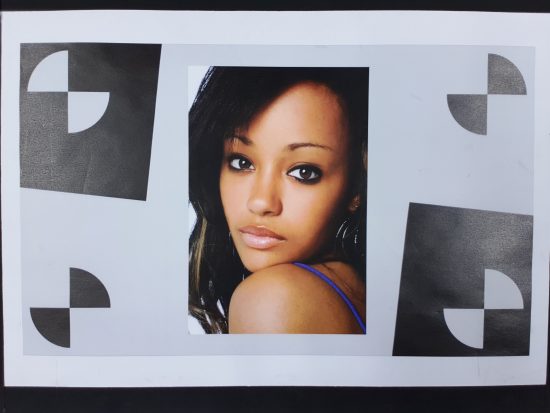
The loss of detail at longer distances becomes especially noticeable in the background of a self-portrait. The comparison images below were shot at a subject distance of 55cm. While that still provides good sharpness on the subject, we can see a quite noticeable loss of detail in the background, which can be problematic if the latter contains elements that are important. Thanks to the Samsung’s autofocus system, the effect is less pronounced at a longer 120cm subject distance, but it is still noticeable.
And the Samsung is certainly not worse than the competition. As you can see in the comparison below, both the Google Pixel 2 and iPhone X lose a noticeable amount of detail in the background of a self-portrait.
The S9+’s lack of depth of field can also be noticeable in group portrait, when not all subjects are in the same plane. In our shot below, focus is very good on the person closest to the camera, but the faces of the people at the back of the group are rendered much softer. Again, a loss of detail is visible on all three comparison devices. These shots were taken at a 55cm subject distance, resulting in a more limited depth-of-field than at longer shooting distances.
Textures and fine detail are areas where smartphone front cameras still lag noticeably behind their rear-camera cousins. With a score of 60 points, the Samsung Galaxy S9 performs respectably in this category, coming very close to the slightly better Google Pixel 2 while putting quite a margin between itself and the iPhone X. However, the results could be better, particularly in low light.
As you can see in the comparison graph below, the Samsung is capable of capturing good detail in bright light, but once below 100 lux, acutance drops quickly and steadily until the S9+ has lost a lot of fine detail in low light. In our comparison, the Google Pixel 2 does slightly better than the Samsung at most light levels, but the iPhone X front camera trails noticeably behind.
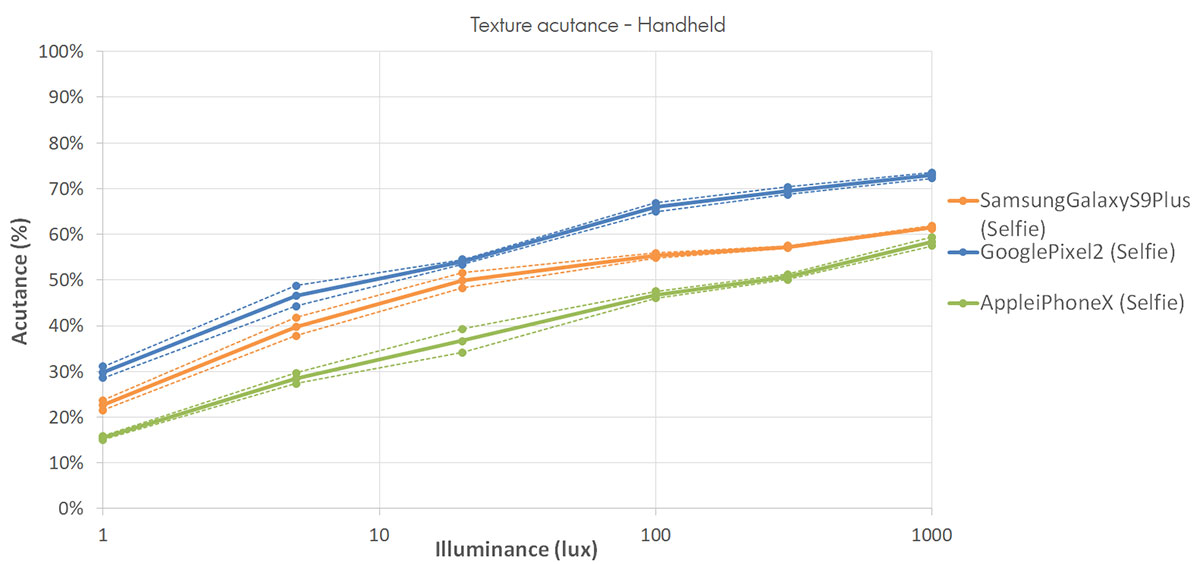
In the bright light comparison shot below, you can see that the Samsung is capable of capturing good detail in good conditions, with only some minor details eradicated. The iPhone X captures very similar levels of detail in this scene.
In indoor conditions at around 100 lux, loss of detail becomes immediately obvious. Textured areas of the face, such as the eyebrows and eyelashes, show strong signs of blurring.
Things pretty much fall apart in very low light. In the samples below, you can see that at a light level of 100 lux, there is still some detail visible on the subject’s beard and lips. At 10 lux, most of it has been blurred away, resulting in an unnaturally smooth rendering of the face.

Noise
Samsung Galaxy S9+
79
90
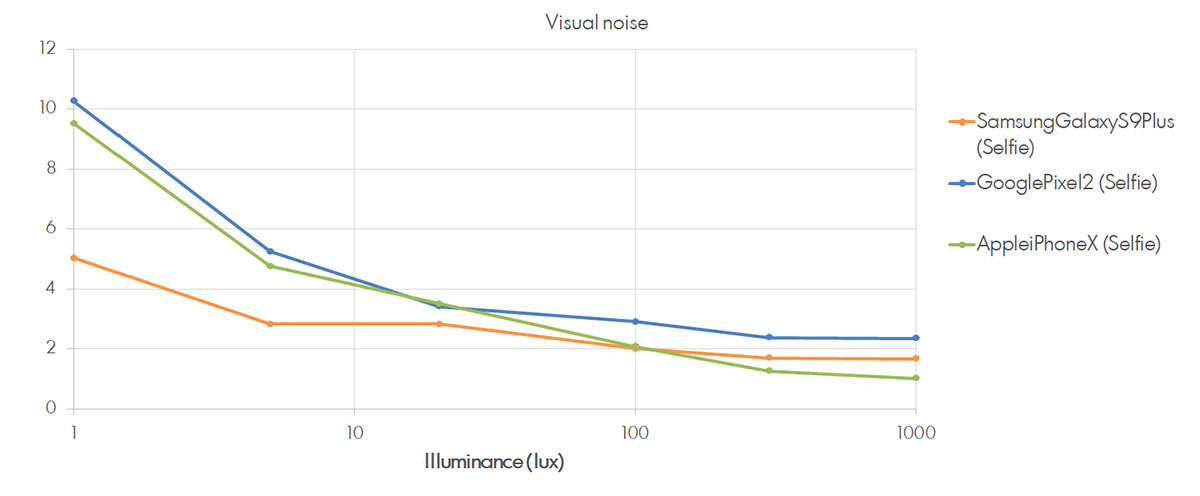
With a score of 79 points, the Galaxy S9+ shines in our noise testing, outperforming both the Apple iPhone X and the Google Pixel 2. Noise on the face is very well-controlled in all light conditions, and is at noticeably lower levels than the competition. In our real-life samples, we can see the same results as in the lab—for example, in the 10 lux images below, the Samsung delivers the lowest noise levels on the subject’s skin.
Blue skies in the background are an area where luminance noise is most noticeable in our test selfies. It is not too intrusive, but some grain is quite noticeable. The same is true for the Google Pixel 2 in the comparison below, but the iPhone X captures a slightly smoother sky.
The Samsung Galaxy S9+ front camera generally controls artifacts well, resulting in a decent Artifacts sub-score of 74 points. We deducted the most points for a noticeable loss of sharpness towards the edges of the image, as you can see in the sample below.
Other problems are fairly minor and include an occasional slight hue shift due to channel-clipping. This happens mostly in blue skies, where the blue turns cyan just before the highlights clip entirely. Occasionally we have also seen a very unnatural rendering of skin. In the example below, you can see how the skin on the illuminated side of the nose has been very heavily smoothed, resulting in a very unnatural-looking effect.

Flash
Samsung Galaxy S9+
81
93
The Samsung Galaxy S9+ comes with a display flash function that very briefly pushes the brightness of the display to its maximum level to illuminate the subject when shooting in flash mode with the front camera. At 81 points, the Samsung achieves a very good score for flash. Light fall-off towards the edges of the frame is clearly noticeable and there is also some color shading; however, exposure on the face is very good, and overall, the image results are very good for a front camera flash.
Levels of detail in the flash shots aren’t great, and there is some luminance noise, but Samsung still does better than many competitors in this respect when shooting with flash in total darkness. Color saturation can be a little on the low side with flash, and this is true both when shooting with flash in complete darkness or at a low ambient light level of 5 lux.
The Samsung Galaxy S9+’s front camera is capable of achieving decent results in bokeh mode, but some room for improvement remains. Depth estimation artifacts are pretty minor, but visible when zooming into the image, and especially when looking closely at portrait subjects’ hair, which often is a little blurry around the edges.
We also found that objects in same the plane as the foreground subject are blurry. In the samples below, the parts of the wall in the same plane as the subject should be in focus, but they show the same blur as the rest of the background, which makes for a slightly unnatural look. On the plus side, image noise has the same appearance across all areas of the image and has not been blurred in the background, same as when shooting with a DSLR.
Video scores explained
The Samsung Galaxy S9+ front camera achieves a good Video score of 81 points. It is a good all-rounder for shooting movies, with generally good face target exposure, well-managed noise levels, and excellent stabilization, but has some weaknesses in terms of color and dynamic range. We calculate the overall video score using the following video sub-scores: Exposure (70), Color (75), Focus (68), Texture (52), Noise (79), Artifacts (88), and Stabilization (56).
Video clips captured with the Samsung front camera show good target exposure on the face outdoors in bright light, as well as indoors in dimmer light. Only in low light have we detected slight underexposure. Just as in stills mode, dynamic range is an issue, and highlight details are often clipped in high-contrast scenes. In addition, the camera is a little slow to trigger the convergence in changing light conditions, which can results in brief periods of over- or underexposure in your footage.
The S9+ renders natural-looking skin tones in most shooting conditions, and the white balance system performs well in bright outdoor light. Things get a little more tricky in lower indoor lighting. We observed some white balance casts in low light, and we also detected some minor color shading in the same conditions. Again, as in stills mode, color saturation is low in many shooting situations.
Despite its autofocus system, focus remains a bit of a weakness for the Galaxy S9 front camera. The camera manages to focus accurately on the subject most of the time, but there is almost always noticeable refocusing at the start of recording and additional refocusing for no obvious reason during recording. In addition, when the focus distance changes, the autofocus has trouble following, sometimes focusing in the wrong direction and showing strong overcompensation effects. Autofocus tracking is very limited as well. Overall, it’s probably fair to say that a fixed-focus solution might have been better.
As you can see in the graph below, the Samsung trails slightly behind its closest competitors in terms of detail at all light levels. Finer details are blurred even in bright light, and while edges are still well-preserved in indoor recording, a lot of finer and low-contrast detail is gone. On the flip side, noise levels are very well under control. While Samsung’s more robust approach towards noise reduction means that detail suffers somewhat, the camera can produce cleaner video output than the competition, with low noise levels across all light situations.
Image stabilization is quite effective in most situations. On the downside, a rolling-shutter effect with its “leaning verticals” is visible when panning, and there is also some slight geometrical deformation on faces when recording while walking. We also observed some artifacts, including pretty strong ringing (halos around hard edges), compression artifacts, and some color bleeding in low-light video.
Conclusion
With an overall score of 81 points, the Samsung Galaxy S9+ achieves an excellent DxOMark Selfie ranking, thanks to very good face exposure, nice skin tones, and clean images with low levels of noise across all light levels in still image mode. Exposure and skin tones are equally good when shooting video, and the very good stabilization system helps keep things steady.
That all said, even the best front cameras are not quite on the same level yet as smartphone main cameras, and the Galaxy S9+ front camera has some room for improvement as well. The device’s biggest problem is a lack of dynamic range, which means brighter backgrounds or highlights on faces clip easily. The level of detail it captures isn’t great either, and in video mode, the autofocus frequently refocuses for no good reason, resulting in jerky footage. In addition, face distortion is visible on videos recorded while walking.
As long as you aware of its shortcomings, the Samsung Galaxy S9+ front camera is great for general use, however, and one of the best selfie cameras your money can currently buy.
Photo Pros
- Well-exposed face in most situations
- Nice skin tones
- Low levels of image noise
Video Pros
- Well-exposed faces in most conditions
- Good white balance results in neutral colors in bright light
- Low noise levels mean clean images across all light levels
Photo Cons
- Lack of dynamic range often results in highlight clipping
- Low saturation sometimes leads to slightly washed out colors
- Finer detail on the face is blurred
- Focus a little soft at longer shooting distances
Video Cons
- AF system refocuses frequently for no good reason
- Highlight and shadow clipping in high-contrast scenes
- Slightly undersaturated colors


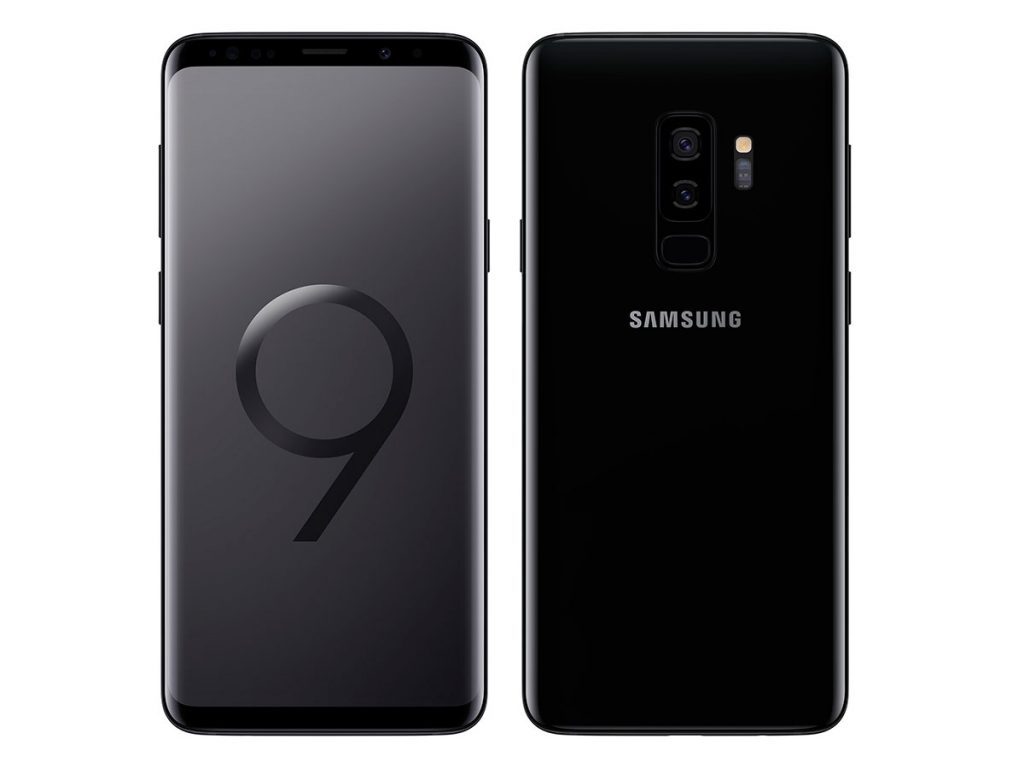


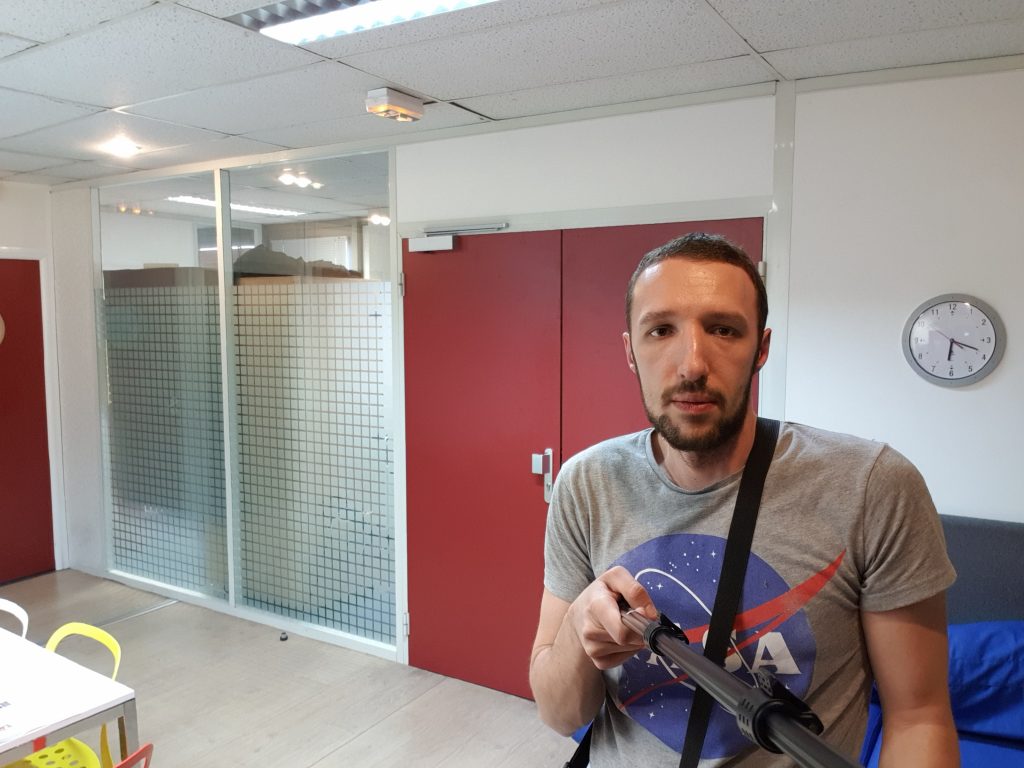





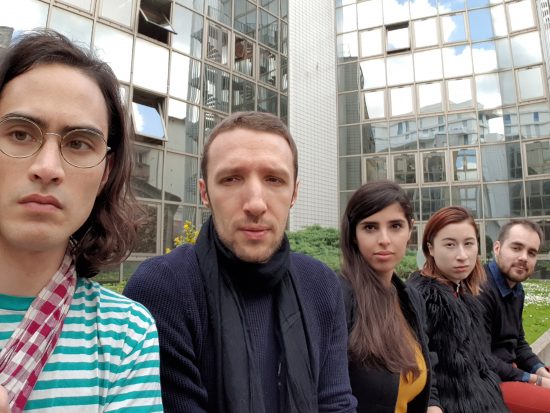

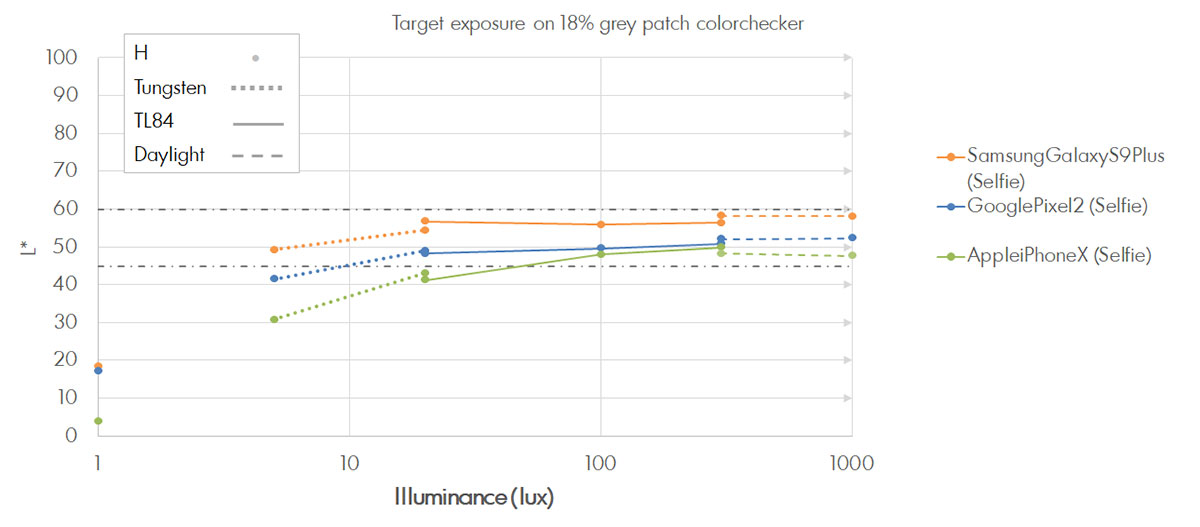




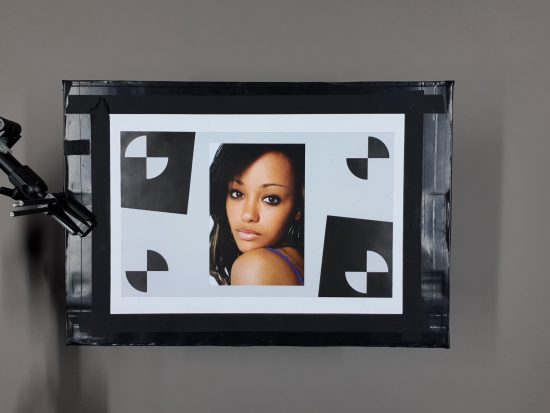
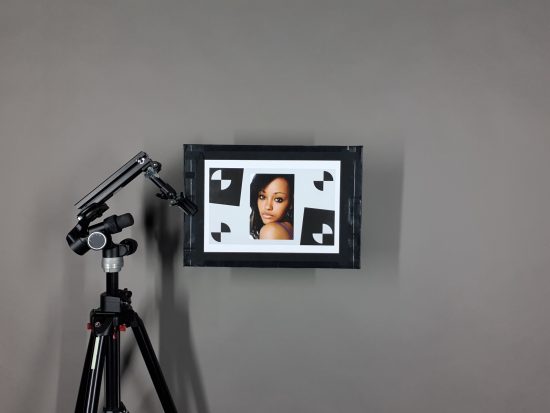





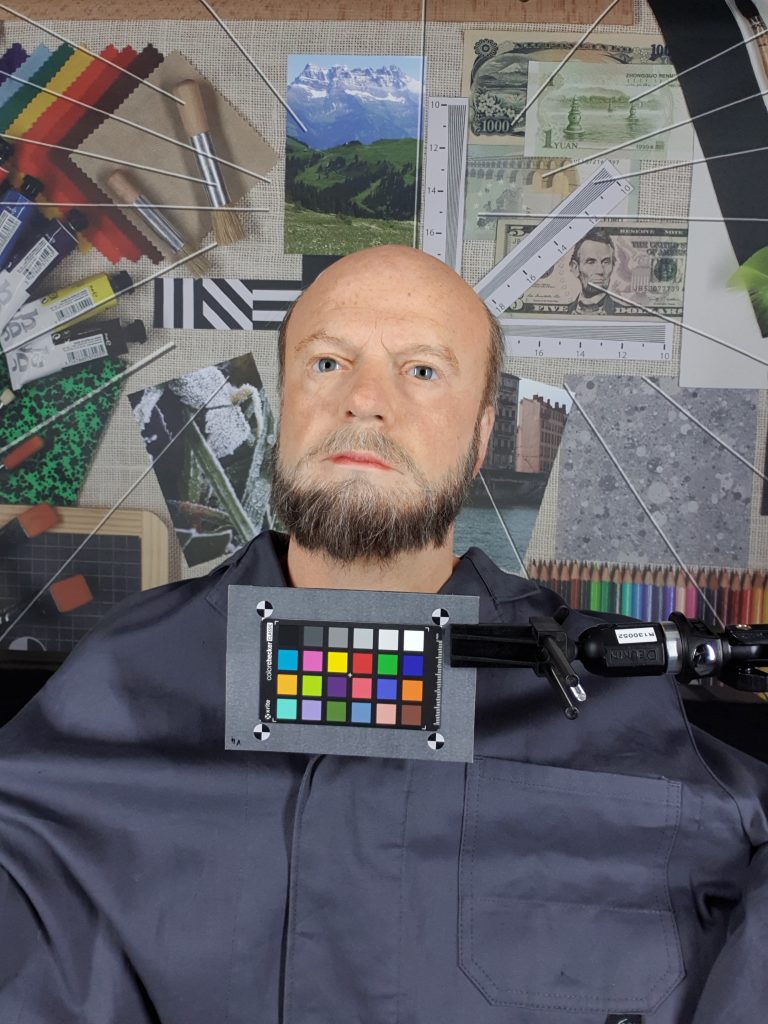
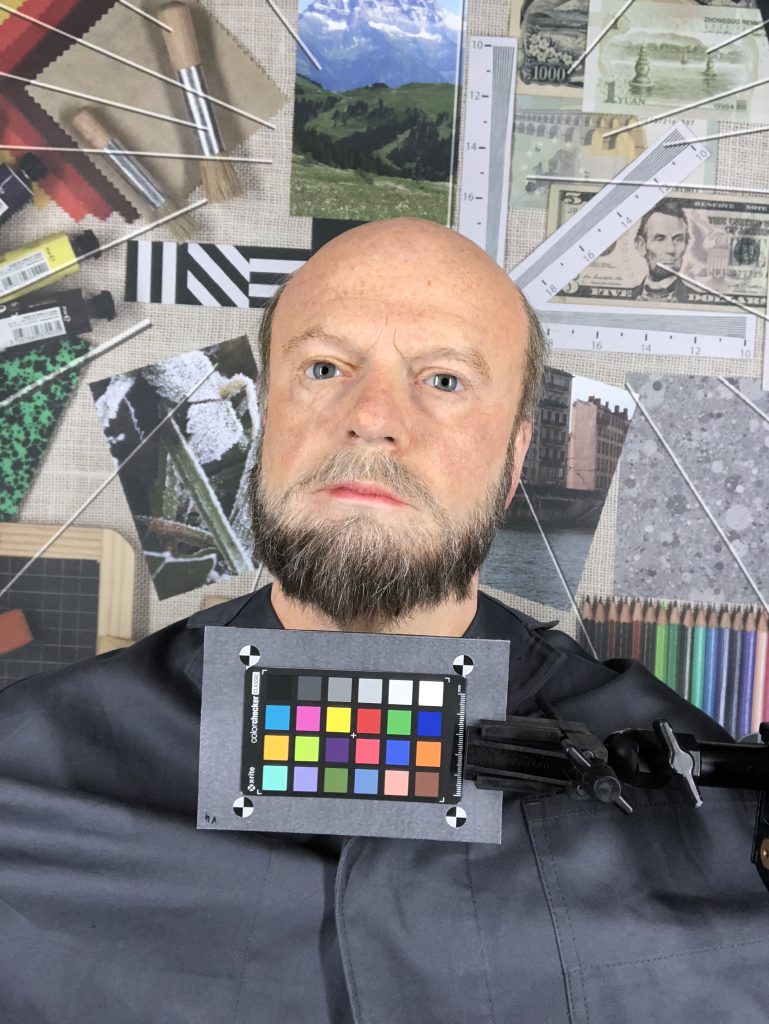
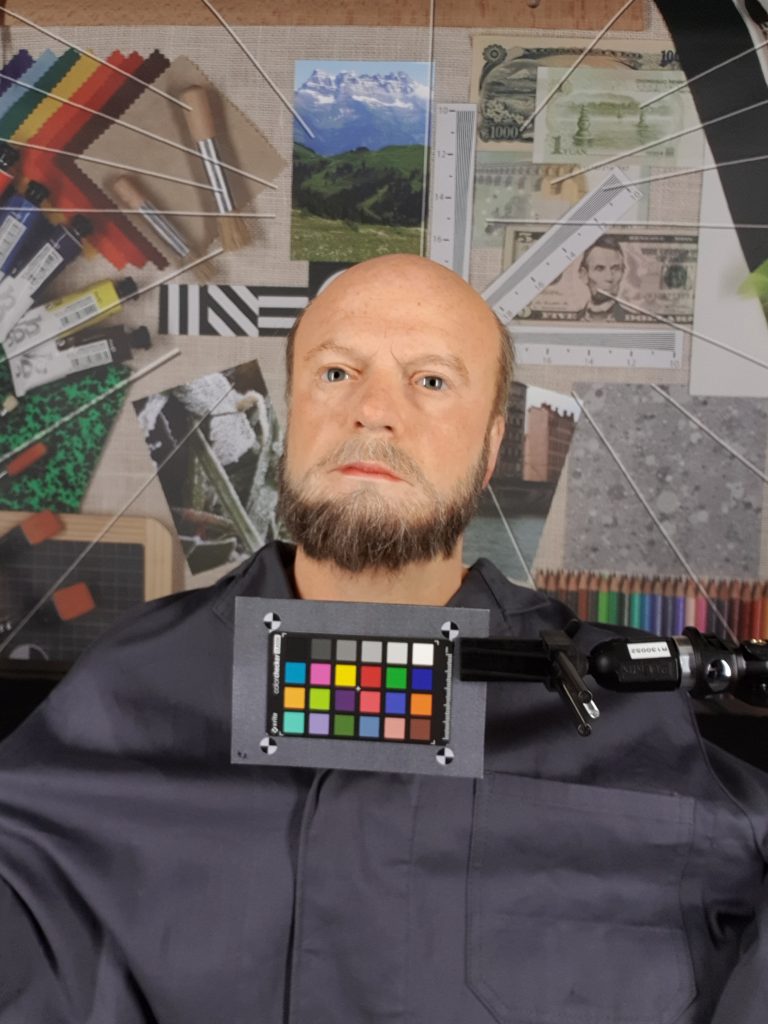
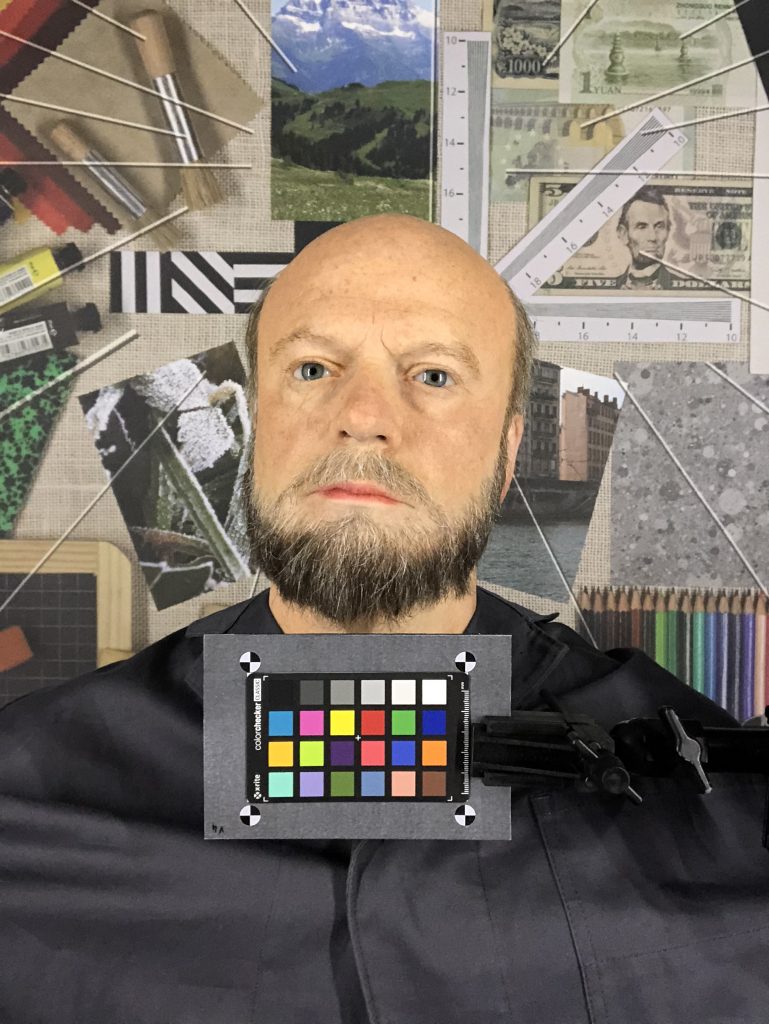


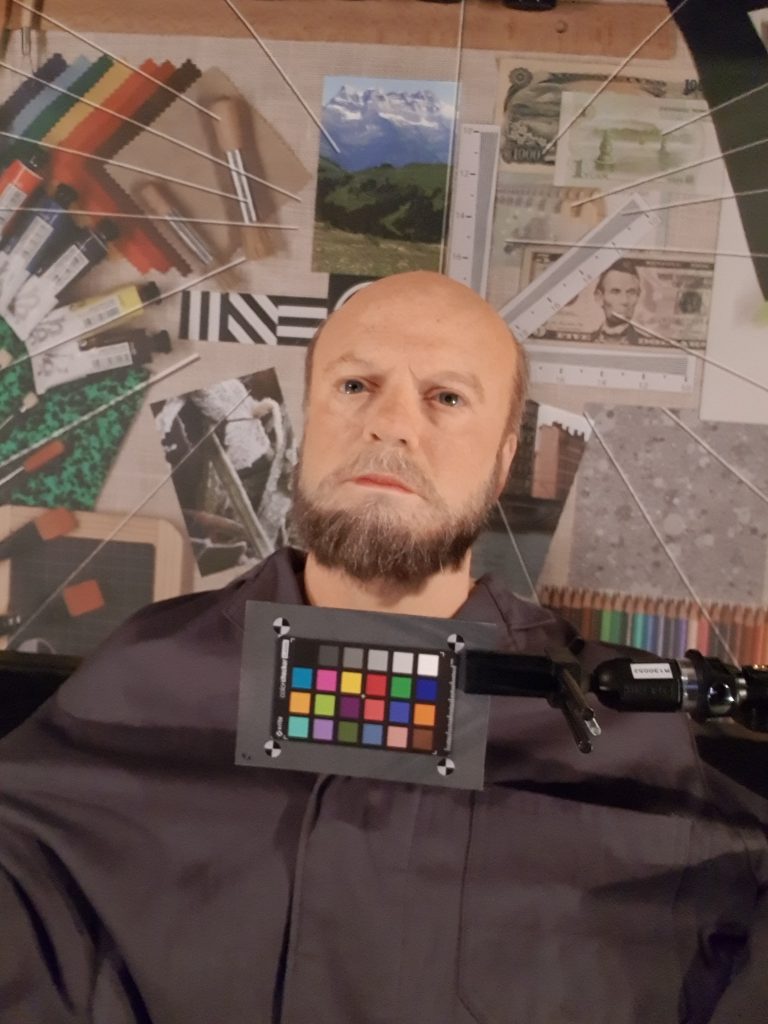
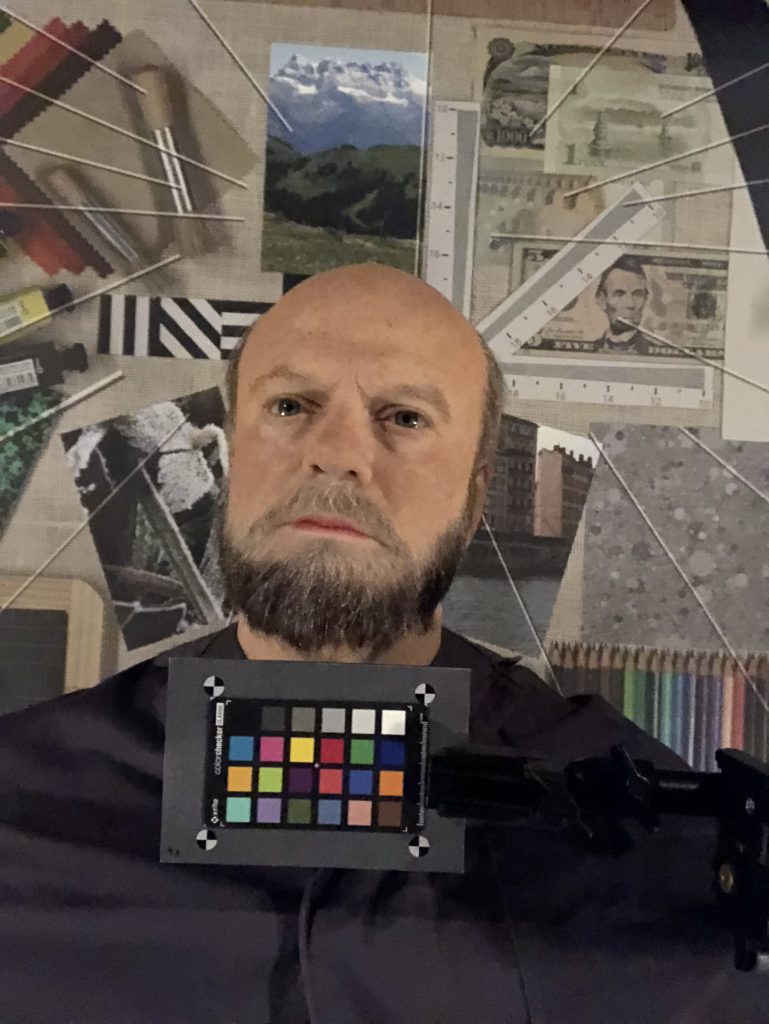



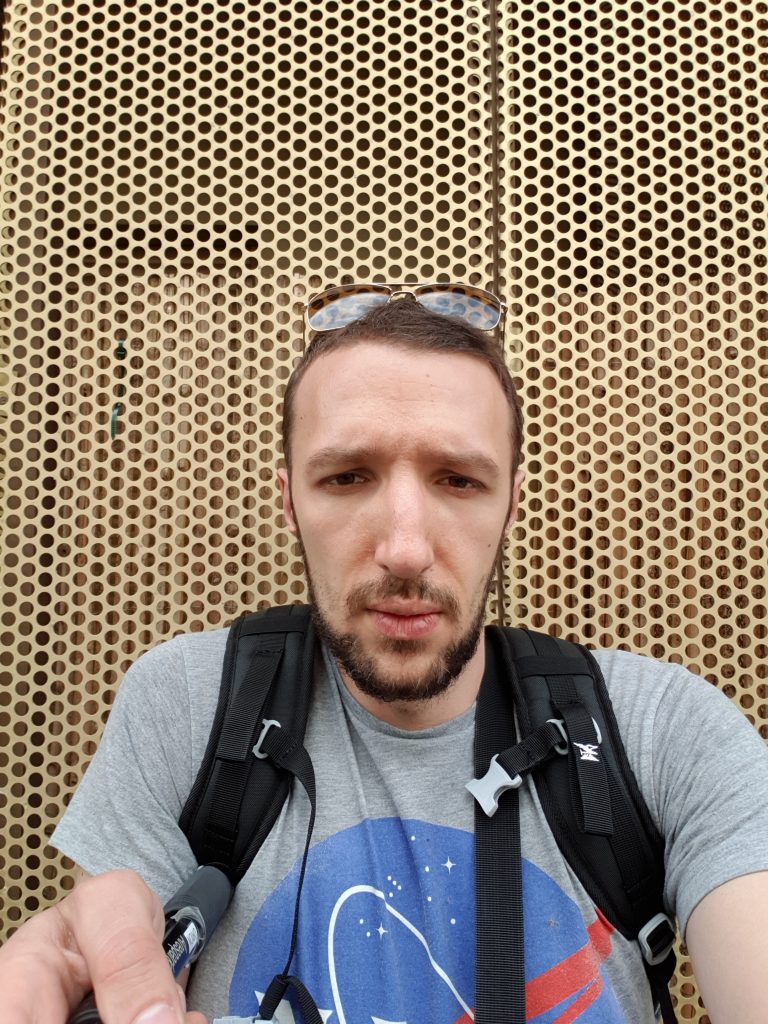





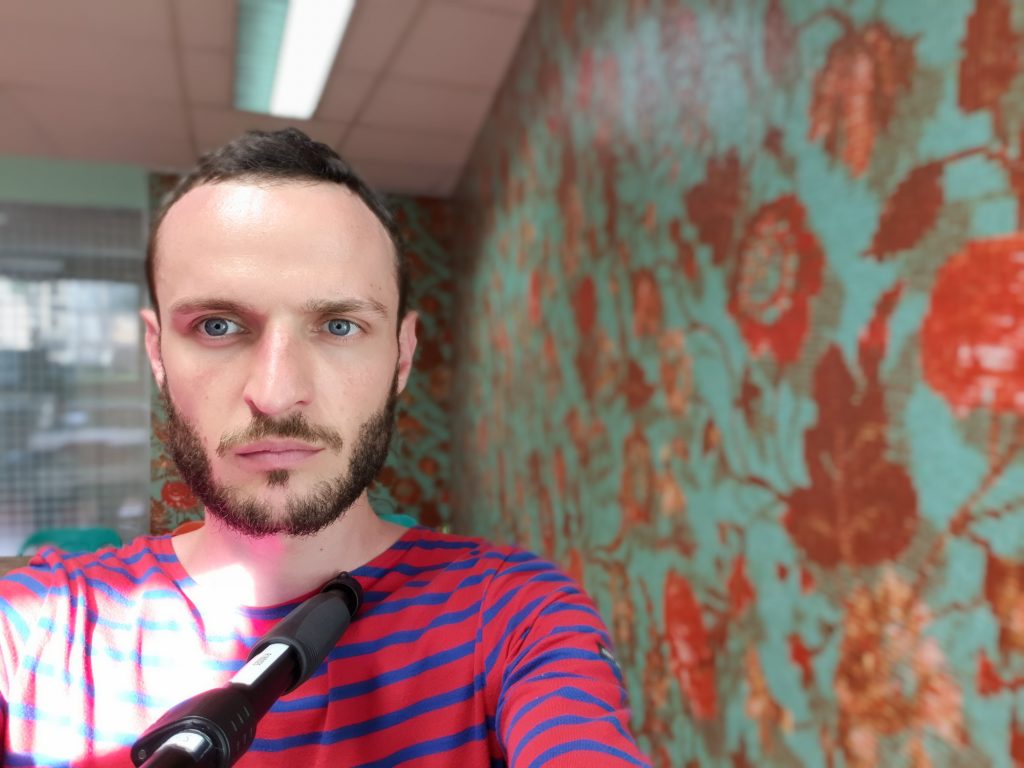
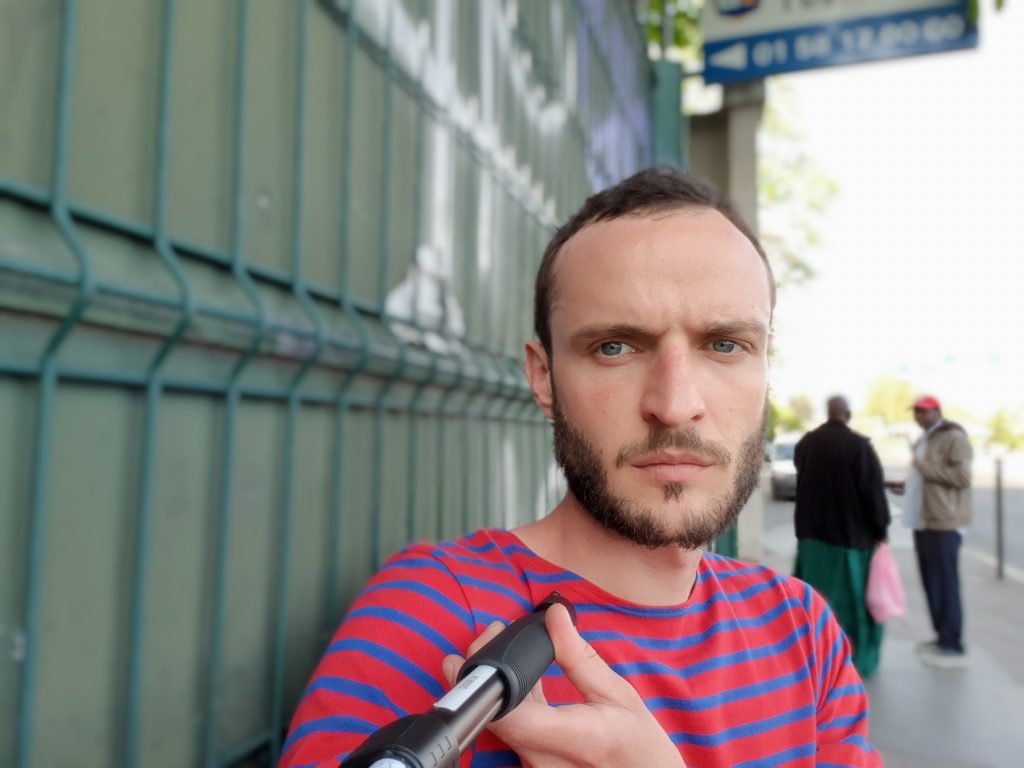
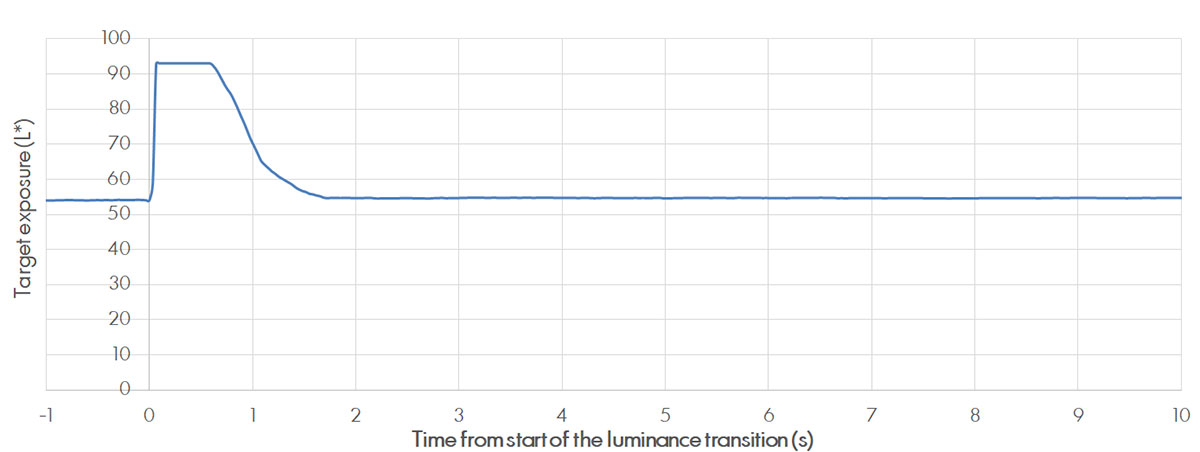

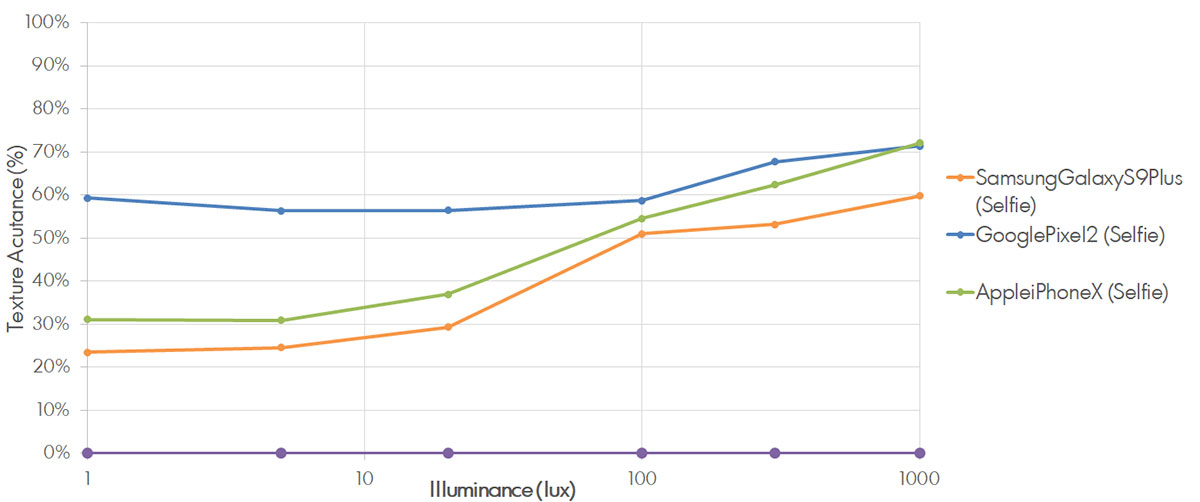
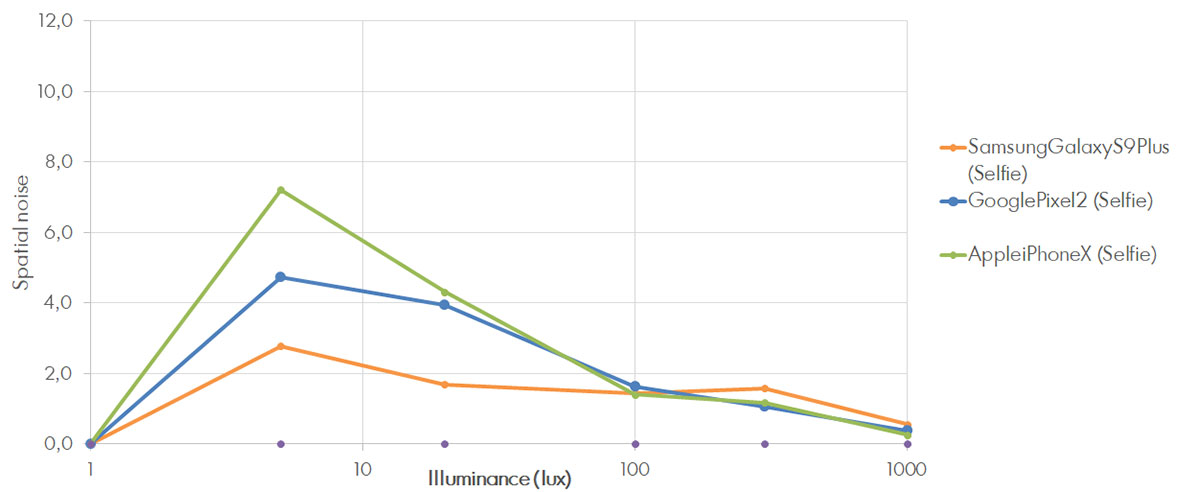
DXOMARK encourages its readers to share comments on the articles. To read or post comments, Disqus cookies are required. Change your Cookies Preferences and read more about our Comment Policy.